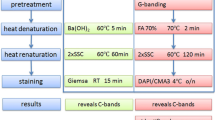Synopsis
Human chromosomes fixed in methanol-acetic acid have been examined by X-ray microanalysis, before, during and after a G-banding and a C-banding procedure. Phosphorus (representing mainly DNA), sulphur and calcium are the most prominent elements in untreated chromosomes. In the G-banding procedure, the calcium is lost during 2 x SSC treatment. In the C-banding procedure, calcium is lost in the preliminary HCl treatment. During the following barium hydroxide treatment a large amount of barium becomes attached to the chromosomes, but is lost again during the subsequent 2 x SSC treatment. In both banding techniques Giemsa staining produces large peaks for sulphur (thiazine dyes) and bromine (eosin), showing that both types of dyes are involved in the staining. Reduction in the phosphorus peak during these procedures may be partly due to extraction of DNA and other chromosomal components, but could also be due to absorption of phosphorus X-rays by heavy elements (barium and bromine).
Similar content being viewed by others
References
Chandler, J. A. (1976). A method for preparing absolute standards for quantitative calibration and measurement of section thickness with X-ray microanalysis of biological ultrathin specimens in EMMA.J. Microscopy 106, 291–302.
Comings, D. E. (1975). Mechanisms of chromosome banding. IV. Optical properties of the Giemsa dyes.Chromosoma 50, 89–110.
Comings, D. E., Avelino, E., Okada, T. A. &Wyandt, H. E. (1973). The mechanism of C-and G-banding of chromosomes.Expl Cell Res. 77, 469–93.
Dev, V. G., Warburton, D. &Miller, O. J. (1972). Giemsa banding of chromosomes.Lancet i, 1285.
Evans, H. J., Buckton, K. E. &Sumner, A. T. (1971). Cytological mapping of human chromosomes: results obtained with quinacrine fluorescence and the acetic-saline-Giemsa technique.Chromosoma 35, 310–25.
Gormley, I. P. &Ross, A. (1972). Surface topography of human chromosomes examined at each stage during ASG banding procedure.Expl Cell Res. 74, 585–7.
Gormley, I. P. &Ross, A. (1976). Studies on the relationship of a collapsed chromosomal morphology to the production of Q- and G-bands.Expl Cell Res. 98, 152–8.
Hall, T. A. (1975). Methods of quantitative analysis.J. Microscopie Biol. Cell. 22, 271–82.
Hall, T. A., Anderson, H. C. &Appleton, T. (1973). The use of thin specimens for X-ray microanalysis in biology.J. Microscopy 99 177–82.
Hungerford, D. A. (1965). Leucocytes cultured from small inocula of whole blood and the preparation of metaphase, chromosomes by treatment with hypotonic KCl.Stain Technol. 40, 333–8.
Kato, H. &Moriwaki, K. (1972). Factors involved in the production of banded structures in mammalian chromosomes.Chromosoma 38, 105–20.
Naora, H., Naora, H., Mirsky, A. E. &Allfrey, V. G. (1961). Magnesium and calcium in isolated cell nuclei.J. gen. Physiol. 44, 713–42.
Pathak, S. &Arrighi, F. E. (1973). Loss of DNA following C-banding procedures.Cytogenet. Cell Genet. 12, 414–22.
Pooley, A. S., Pardon, J. F. &Richards, B. M. (1973). Studies by electron microscopy and X-ray diffraction of isolated nucleohistone and its relationship to chromatin structure.J. Cell Biol. 59, 268a.
Reed, S. J. B. (1975).Electron Microprobe Analysis. Cambridge: University Press.
Ris, H. (1975). Chromosomal structure as seen by electron microscopy. In:The Structure and Function of Chromatin, Ciba Foundation Symposium 28 (new series), pp. 7–23. Amsterdam: Associated Scientific Publishers.
Ris, H. &Kubai, D. F. (1970). Chromosome structure.Ann. Rev. Genet. 4, 263–94.
Robison, W. L. (1973). Applications of the electron microprobe to the analysis of biological materials. In:Microprobe Analysis (ed., C. A. Anderson), pp. 271–321. New York: John Wiley & Sons.
Ross, A. &Gormley, I. P. (1973). Examination of surface topography of Giemsabanded human chromosomes by light and electron microscopic techniques.Expl Cell Res. 81, 79–86.
Russ, J. C. (1974). X-ray microanalysis in the biological sciences.J. submicr. Cytol. 6, 55–79.
Schmiady, H., Wegner, R.-D. &Sperling, K. (1975). Relative DNA content of human euchromatin and heterochromatin after G, C and Giemsa 11 banding.Humangenetik 29, 85–9.
Steffensen, D. M. (1961). Chromosome structure with special reference to the role of metal ions.Int. Rev. Cytol. 12, 163–97.
Sumner, A. T. (1972). A simple technique for demonstrating centromeric heterochromatin.Expl Cell Res. 75, 304–6.
Sumner, A. T. (1974). Involvement of protein disulphides and sulphydryls in chromosome banding.Expl Cell Res. 83, 438–42.
Sumner, A. T. &Evans, H. J. (1973). Mechanisms involved in the banding of chromosomes with quinacrine and Giemsa. II. The interaction of the dyes with the chromosomal components.Expl Cell Res. 81, 223–36.
Sumner, A. T., Evans, H. J. &Buckland, R. A. (1971). New technique for distinguishing between human chromosomes.Nature New Biol. 232, 31–2.
Sumner, A. T., Evans, H. J. &Buckland, R. A. (1973). Mechanisms involved in the banding of chromosomes with quinacrine and Giemsa. I. The effects of fixation in methanol-acetic-acid.Expl Cell Res. 81, 214–22.
Author information
Authors and Affiliations
Rights and permissions
About this article
Cite this article
Sumner, A.T. Changes in elemental composition of human chromosomes during a G-banding (ASG) and a C-banding (BSG) procedure. Histochem J 10, 201–211 (1978). https://doi.org/10.1007/BF01003305
Received:
Revised:
Issue Date:
DOI: https://doi.org/10.1007/BF01003305




